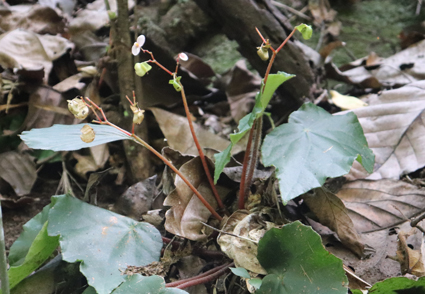Abstract
Recent botanical excursions resulted in the recollection of Begonia anisoptera, as part of our ongoing work on exploring and conserving the flora of Zamboanga Peninsula. We lectotypify this name in accordance with ICN for algae, fungi, and plants of the Shenzhen code Art. 9.3, 9.11 and 9.12. Furthermore, we have provided a comprehensive description, photographs to aid identification, updated geographical distribution, and a preliminary IUCN conservation assessment.
References
- Ardi, W.H., Ardaka, I., Kusuma, Y.W., Lewis, C.L. & Thomas, D.C. (2022) Studies of Begonia (Begoniaceae) from the Moluccas IV: Two new species from Halmahera, Indonesia. Taiwania 67 (3): 335–340.
- Amoroso, V.B., Lamparas, R.J.V., Lagunday, N.E., Dapar, M.L.G. & Rubite, R.R. (2023) Begonia fritschiana (Begoniaceae, Begonia section Baryandra), a new species from Quezon, Bukidnon, Philippines. Phytotaxa 587 (1): 39–46. https://doi.org/10.11646/phytotaxa.587.1.5
- Bachman, S., Moat, J., Hill, A., de la Torre, J. & Scott, B. (2011) Supporting Red List threat assessments with GeoCAT: Geospatial Conservation Assessment Tool. ZooKeys 150: 117–126. https://doi.org/10.3897/zookeys.150.2109
- Beentje, H.J. (2010) The Kew Plant Glossary: An Illustrated Dictionary of Plant Terms. Royal Botanic Gardens, Kew, Richmond, Surrey.
- Hughes, M., Moonlight, P.W., Jara, A. & Pullan, M. (2015–2023) Begonia Resource Centre. Available from: http://padme.rbge.org.uk/begonia (accessed 17 May 2023).
- Hughes, M., Rubite, R.R., Blanc, P., Chung, K.F. & Peng, C.I. (2015) The Miocene to Pleistocene colonization of the Philippine archipelago by Begonia sect. Baryandra (Begoniaceae). American Journal of Botany 102: 695–706. https://doi.org/10.3732/ajb.1400428
- Hughes, M., Coyle, C., & Rubite, R. R. (2010) A revision of Begonia section Diploclinium (Begoniaceae) on the Philippine island of Palawan, including five new species. Edinburgh Journal of Botany 67 (1): 123–140. https://doi.org/10.1017/S0960428609990266
- IUCN Standards and Petitions Committee (2022) Guidelines for Using the IUCN Red List Categories and Criteria. Version 15.1. Available from: https://www.iucnredlist.org/documents/RedListGuidelines.pdf (accessed 25 May 2023)
- Naive, M.A.K., Calimbo, L.G.L., Cudal, M.G., Alejandro, G.J.D. & Yu, W.B. (2022). Taxonomy of the genus Begonia (Begoniaceae) in Mindanao, Philippines IV: Begonia bangsamoro subsp. bagasa (Begonia section Petermannia), a new subspecies from Zamboanga del Sur. Phytotaxa 559 (1): 88–94. https://doi.org/10.11646/phytotaxa.559.1.10
- Mazo, K.R.F., Salatan, N.L., Santos, I.E.A. & Rubite, R.R. (2022) Two new species of Begonia (section Petermannia, Begoniaceae) from Zamboanga Peninsula, Philippines with notes on an amended description of B. elatostematoides. Taiwania 67 (3): 441–449.
- Merrill, E.D. (1912 [1911]) The Philippine species of Begonia. Philippine Journal of Science section C, Botany 6: 369–406.
- Moonlight, P.W., Ardi, W.H., Padilla, L.A., Chung, K.F., Fuller, D., Girmansyah, D., Hollands, R., Jara-Muñoz, A., Kiew, R., Leong, W.C., Liu, Y., Mahardika, A., Marasinghe, L.D.K., O’Connor, M., Peng, C.-I, Pérez, A.J., Phutthai, T., Pullan, M., Rajbhandary, S., Reynel, C., Rubite, R.R., Sang, J., Scherberich, D., Shui, Y.M., Tebbitt, M.C., Thomas, D.C., Wilson, H.P., Zaini, N.H. & Hughes, M. (2018) Dividing and conquering the fastest-growing genus: Towards a natural sectional classification of the megadiverse genus Begonia (Begoniaceae). Taxon 67 (2): 267–323. https://doi.org/10.12705/672.3
- Rubite, R.R. & Madulid, D.A. (2009) The rediscovery of Philippine Begonia. Blumea 54: 267–268. https://doi.org/10.3767/000651909X476256
- Rubite, R.R. (2012) Delimitation of Begonia L. sections Diploclinium and Baryandra (Begoniaceae) in the Philippines. Asia Life Sciences 21 (2): 363–373.
- Thiers, B.M. (2022) Index Herbariorum: a global directory of public herbaria and associated staff. New York Botanical Garden’s Virtual Herbarium. Available from: http://sweetgum.nybg.org/science/ih/ (accessed 17 May 2023)
- Turland, N.J., Wiersema, J.H., Barrie, F.R., Greuter, W., Hawksworth, D.L., Herendeen, P.S., Knapp, S., Kusber, W.-H., Li, D.-Z., Marhold, K., May, T.W., McNeill, J., Monro, A.M., Prado, J., Price, M.J. & Smith, G.F. (2018) International Code of Nomenclature for algae, fungi, and plants (Shenzhen Code) adopted by the Nineteenth International Botanical Congress Shenzhen, China, July 2017). Regnum Vegetabile 159. Koeltz Botanical Books, Glashütten. https://doi.org/10.12705/Code.2018
- Yumul, G.P., Dimalanta, C.B., Tamayo, R.A., Maury, R.C., Bellon, H., Polve, M., Maglambayan, V.B., Querubin, C.L. & Cotten, J. (2004) Geology of the Zamboanga Peninsula, Mindanao, Philippines: an enigmatic South China continental fragment? Geological Society, London, Special Publications 226: 289–312. https://doi.org/10.1144/GSL.SP.2004.226.01.16


